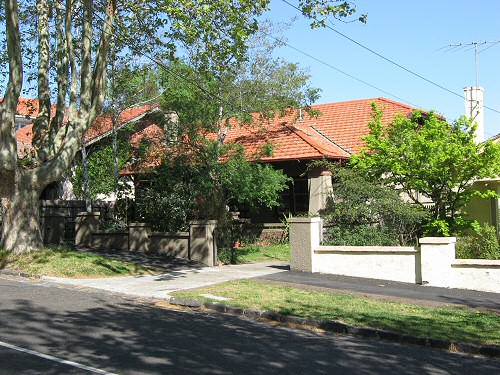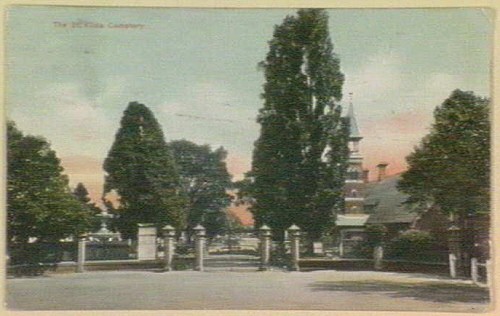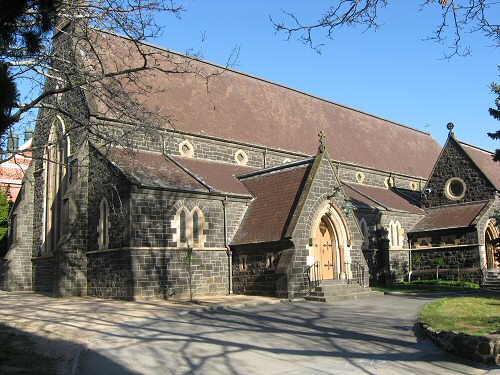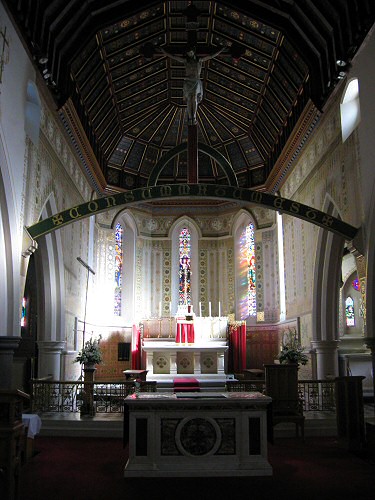| |
St Kilda and Elwood c 1920 - 1932
| |
1. 23 Murchison St
Albert and Vera Jacka purchased 23 Murchison Street East St Kilda in 1925, and lived there up to the end of 1931, except for a period of one year (November 1929 – November 1930), when it was rented to Louis Blashki, a commercial traveller. It was a brand new Californian Bungalow house in a group of three that had been built by P.S. Walsh Pty Ltd, a building company located in Dandenong Road.

Albert and Vera Jacka’s house at 23 Murchison Street today
2. St Kilda Cemetery
The St Kilda cemetery is large and historic, as it dates from 1869. Apart from Albert Jacka and his parents, the cemetery is the last resting place of Australia’s second Prime Minister, Alfred Deakin, Rabbi Jacob Danglow, and many other notables. Albert Jacka’s grave is situated in the middle of the cemetery along the main thoroughfare, and his headstone, which was consecrated in May 1932 and opened by Brigadier-General Charles Brand, looks directly across the cemetery to Murchison Street, where Albert Jacka once lived.

Photograph courtesy State Library of Victoria
St Kilda Cemetery in 1909

In this photograph, Brig- Gen. Charles Brand who was chairman of the committee organising the memorial and a house for Albert Jacka’s wife and child, unveils the headstone and bronze relief of Albert Jacka’s head while Vera and Betty Jacka (left) look on. Also visible in the photograph is Cr. Moroney, the Mayor of St Kilda.
Photo Currently Unavailable
Photo courtesy Library University of NSW - Duntroon
Captain Albert Jacka’s memorial stone as it appears today.
3. St Mary’s church, Dandenong Road
St Mary’s Catholic church in East St Kilda was built between 1859 and 1897 one of the first Melbourne projects of noted English architect William Wardell (who also designed St Patrick’s Cathedral in Melbourne and St Mary’s Cathedral in Sydney). Wardell personally worshipped at this church.
Photo Currently Unavailable
Photograph from Cooper (1931) History of St Kilda
St Mary’s church in 1930
Albert Jacka, who was baptised an Anglican, married Frances Veronica Carey at St Mary’s church on Dandenong Road in East St Kilda on 17 January, 1932. Vera’s younger brother James Carey was the best man, and signed the wedding certificate as witness. The wedding was extremely low key, and no photographs of it (if any were ever taken) appear to have survived. St Mary’s church has been well preserved, and is still functioning.

Exterior of St Mary’s church toda

This photograph shows the altar and stained glass windows of the church as it looks today.
4. St George’s church, Chapel St
St George’s Presbyterian church was built in 1877 and was the parish of Chaplain Captain Andrew Gillison MA, who was the first Padre of the 14th Battalion and went with them to Gallipoli. At Hill 60 on the Gallipoli Peninsula Gillison and one of his colleagues were shot and killed by snipers as they attempted to save a wounded soldier. The Rev. Andrew Gillison is commemorated every year at the church on the Sunday closest to 20 August.
Prior to embarkation for Egypt, Rev. Gillison consecrated the Kings and Regimental Colours of the 14th Battalion at a ceremony on the Lower Esplanade at St Kilda. The Colours were stored at St George’s church while the 14th Battalion was at the war. In April 1930, at the initiative of Captain Albert Jacka, the Colours were taken from St Georges and placed in the foyer of the St Kilda Town Hall, where they have remained to this day.

Photograph from Cooper, (1931) History of St Kilda
St Georges church
5. Lissa Thorn, 10 Redan St
‘Lissa Thorn’ was an apartment building at 10 Redan St East St Kilda. It was the city residence of Newton Wanliss (father of Captain Harold Wanliss) during the 1920s. Being located so close to Albert Jacka’s residences during the 1920s, it is likely that they met there to discuss the book that Newton was writing, The History of the 14th Battalion AIF. The building has been demolished and a photograph has not been found.
6. St Kilda Masonic Lodge, No. 303
Built in 1876 as a Baptist Church, in 1922 this building in Crimea Street, East St Kilda became the Temple of Masonic Lodge No. 303. It is known that Albert Jacka became a Freemason around this time, and it is possible (though not an established fact) that he became a member of this Lodge. If so, there is irony in the number of the lodge.

St Kilda Masonic Lodge
7. St Kilda Town Hall
The St Kilda Town Hall was opened in 1890 based on a design by noted architect William Pitt, and included an innovative retracting ceiling over the main hall, which could accommodate 1,000 people. Due to funds drying up in the Crash of 1893, the grand vision of an ornate classical tower never materialised, and the red brick exterior was not stuccoed for many years. The classical portico was not part of the original plan, and was added in 1925.

Photograph from Cooper, (1931) History of St Kilda
The Town Hall in 1930 after the portico had been added (in 1925)
The main hall had a magnificent organ, and was the site of numerous gala events and balls. It hosted several dances during the visit of the US Pacific Fleet squadron in 1925.

Photograph from Cooper, History of St Kilda, 1931
Presentation of the 14th Battalion’s regimental and King’s Colours at the St Kilda Town Hall, 27 April, 1930
On 27 August, 1930, Albert Jacka’s plan to relocate the Colours of the 14th Battalion to the foyer of the St Kilda Town Hall from St George’s church was realized in a ceremony that took place outside the portico. In the photograph below (taken from Cooper, History of St Kilda), Captain Albert Jacka is shown standing at attention in front of the fourth pillar on the right. However, this image was grafted onto the photograph (from a studio shot), as the original photograph did not include Albert Jacka.

Photograph courtesy of State Library of Victoria
This meeting at the Town Hall in the 1950s was to present naturalisation certificates new citizens. Note the organ, which was later destroyed in the fire.
In 1931, while he was Mayor of St Kilda, Cr. Albert Jacka chaired a public meeting of the All For Australia League at the Town Hall. The main speaker was Ernest Turnbull, President of the League’s Victorian Chapter, and formerly State President of the RSSILA (forerunner of the RSL). The meeting established a St Kilda branch of the movement, which saw the establishment of the (conservative) United Australia Party, which was led to victory in the December 1931 election by former Labor Treasurer Joseph Lyons.

Photograph courtesy of Carl Johnson
Program from the Jubilee Dinner of the 14th Battalion, which was held at the St Kilda Town Hall in 1964. Bill Jacka’s signature is visible on it.

The St Kilda Town Hall today.
8. St Kilda Botanical Gardens
The St Kilda Botanical Gardens date back to 1860-61. The Planting Committee of the Council is understood to have consulted Baron Sir Ferdinand von Mueller, director of the Royal Botanical Gardens 1857-1873, on the design and choice of tree species, in particular the pines, cypresses and Moreton Bay figs. By 1900 there was a gardener’s lodge, and a fountain. In 1914 a lily pond was added.

Photograph from Cooper, History of St Kilda, 1931
A scene near the entry to the St Kilda Botanical gardens

A lily pond in the St Kilda Botanical Gardens
9. Mrs Susan Futcher’s house, 52 Mitford St, Elwood
Mrs Futcher was the babysitter for Albert and Vera Jacka’s adopted daughter Betty. During 1929-30 her house, at 52 Mitford Street Elwood, was relatively close to the apartment being rented by Albert Jacka at the corner of Gordon Avenue and Broadway.

10. ‘Narooma’ Corner Broadway and Gordon Ave
Albert Jacka and his family lived in an apartment at ‘Narooma’ on the corner of Broadway and Gordon Avenue between 1929 and 1930, while their house was being rented to a commercial traveller. This was likely due to Albert Jacka’s shortage of cash at this time because his business was suffering reduced patronage in the Great Depression. It was, however, located relatively close to Betty Jacka’s baby sitter, Mrs Futcher. ‘Narooma’ has recently been condemned.

11. Maison de Luxe dance hall
The Maison de Luxe dance hall was located at the Elwood Junction. Numerous dance functions were held here over many decades. In 1925 the venue hosted a ‘Star spangled banner Ball’ for visiting sailor from the US Pacific squadron. The site is now occupied by an apartment block.

12. 60 Chaucer St
This is the last house occupied by Albert Jacka prior to his hospitalization and subsequent death. Situated on the corner of Chaucer Street and Blessington streets, the house looks over a park towards the bay. The Luna Park is one block away, and it is closely situated to the St Kilda Soldiers’ and Sailor’s Memorial Hall, home of the St Kilda Army and Navy Club, which was frequented by Albert Jacka.

13. St Kilda Soldiers’ and Sailors’ Memorial Hall
The St Kilda Soldiers’ and Sailors’ Memorial Hall was conceived as a community funded project in the early 1920s to become the home of the St Kilda Army and Navy club ( later the St Kilda RSL club). While it was being built during 1923, the Melbourne-based architects, Hudson and Wardrop (both ex-AIF) won an international competition for the design of the Shrine of Remembrance. The complex included several shops at ground level, meeting rooms and a hall on the second level (it was a cinema from 1927 to 1957), and 12 flats for accommodation on the upper levels. Under the original trust deed this accommodation could only be used by ex-AIF personnel and their dependents.

Photograph from Cooper (1930) History of St Kilda
The Memorial Hall in 1930 (note the red and white striped barber shop front)

The St Kilda RSL club in Acland Street today. A plaque commemorating Albert Jacka stands at the entry, and there is an ‘Albert Jacka Bar’ inside.

The portrait of Albert Jacka donated to the club by Vera Jacka in 1932 still hangs in the club.
14. Luna Park
Luna Park was established in 1911 by an American amusement centre tycoon J.D. Williams, who pioneered the concept at Coney Island, New York. The Greater J.D. Williams Amusement Company partnered with Phillips Brothers of Los Angeles to bring amusement parks to the Australian continent. Another version of Luna Park was constructed in Adelaide soon after, but was not successful, so it was dismantled and re-built at Milson’s Point in Sydney. Melbourne’s Luna Park was closed during the Great War, but was re-opened in 1923, and operates to this day.

During the 1920s Sir John Monash was a director of Luna Park. Its facilities and amusements were used more than once during the Great Depression to raise money for the unemployed.
15. Alfred Square
Alfred Square is elevated, affording a commanding view of the St Kilda Baths and Port Phillip Bay beyond. In the 1930s this was where the Queen of Flowers pageant that came down St Kilda Road from the city terminated. It was in Alfred Square that the Queen of Flowers would declare an end to the winter amid a carnival atmosphere along the Upper and Lower Esplanades fronting the beach.
A 1905 memorial to the Boer War stands in Alfred Square, and the several VCs who lived in St Kilda, including Albert Jacka, are commemorated on a plaque nearby.

Photograph courtesy of State Library of Victoria
Alfred Square during the 1940s, with the St Kilda Baths behind it
16. St Leonards. 10 St Leonards Lane
‘St Leonards’ was a large guest house situated on a massive block at 10 St Leonards Lane. It was owned by the Cummings family, and was the site of numerous Café Chantant afternoons and evenings aimed at raising funds for several causes and charities (including raising money to pay for the St Kilda Soldiers’ and sailors’ Memorial Hall). Entertainments included musicians, tennis tournaments, billiards and bridge competitions.
‘St Leonards’ was demolished, and in the mid 1990s a Nonda Katsalidis designed apartment block was built on the site.

Photograph courtesy of State Library of Victoria
17. Esplanade Hotel
In 1874 architects were commissioned to design three large terrace houses on a small hill overlooking Port Phillip Bay. The terrace was to be called ‘the Esplanade’. However, the owner changed his mind and the building became a 60 room hotel of the same name. From 1892 to 1904 one of Australia’s best known benefactors, Alfred Felton (founder of ACI and Drug Houses of Australia) lived there.

Photograph from Cooper, History of St Kilda, 1931
18. St Kilda Baths
The original St Kilda Baths dating from the 1800s burnt down in 1925, and was rebuilt in 1930-31 while Cr Albert Jacka VC JP was Mayor of St Kilda. Over the decades since that time the baths fell into disrepair, but were recently refurbished and are currently operating.

Photograph courtesy of State Library of Victoria
St Kilda baths from Alfred Square in the 1940s

Photograph from Cooper History of St Kilda, 1931
St Kilda baths were under constriction during Albert Jacka’s term as Mayor of St Kilda.

Photograph from Cooper History of St Kilda, 1931
The old St Kilda Baths burnt down in 1925
19. Royal Melbourne Yacht Club

Photograph from Cooper, History of St Kilda, 1931
The original Royal Melbourne Yacht Club building (at left) watched over the 14th Battalion as its regimental and King’s Colours were being consecrated on the St Kilda foreshore in December 1914 by the Chaplain of the battalion, Padre Andrew Gillison.

Photograph from Cooper, History of St Kilda, 1931
The yacht club also served as the backdrop for the 1920 ceremony on the St Kilda foreshore where medals were presented to ex-diggers. It is noticeable that the trees that flanked the old Royal Melbourne Yacht Club building are much taller than in the 1914 photograph above.

Photograph from Cooper, History of St Kilda, 1931
The new yacht club was built in a modern art deco style, with large observation decks for viewing the bay.

Photograph courtesy of Australian National Library
The view of the St Kilda Pier from the Royal Melbourne Yacht Club building, looking over the yachts.
20. Cenotaph

Photograph from Cooper, History of St Kilda, 1931
The Cenotaph at the head of Fitzroy Street, St Kilda has its back to the sea, and was erected in memory of those who lost their lives during the Great War. On Anzac Day in 1931, while he was Mayor of St Kilda, Cr. Albert Jacka VC placed a wreath at the base of the Cenotaph.
21. Catanti Gardens
Italian engineer Enrico Catani came from Florence, and was employed by the St Kilda Council to develop the St Kilda foreshore. He lived on Blessington Street in St Kilda, attended Anglican church, and lost one of his sons at Pozieres. Today the gardens that he designed to present the ambience of Italian seaside resorts carry his name.

Photograph from Cooper, History of St Kilda, 1931
A flower bed at the Catani Gardens, with the Cenotaph and Royal Melbourne Yacht Club building in the background.
22. St. Kilda Pier
The St Kilda Pier was for many years the VIP gateway to Melbourne. When an important person or group arrived at Port Melbourne they were promptly escorted to a smaller boat that transported them to the preferred entry point. The list of VIPs included Admiral Charles Sperry of the 1908 US Great White Fleet, a stream of British Governors and Governors General, Lord Jellicoe of Scapa, Lieutenant-General Sir John Monash, when he arrived in 1919, the Prince of Wales in 1920, Admiral Coontz and six Vice-Admirals of the US Pacific Fleet in 1925, and the Duke and Duchess of York in 1927.

Photograph from Cooper, History of St Kilda, 1931
The Prince of Wales arrives at the St Kilda Pier, May 1920.

Photograph from Cooper, History of St Kilda, 1931
Admiral Coontz and six Vice-Admirals of the US Pacific Squadron are welcomed at the St Kilda Pier in 1925.


Photograph from Cooper, History of St Kilda, 1931
The Duke and Duchess of York arriving at the St Kilda Pier in 1927. Note the outline of the rollercoaster ride at Luna Park in the background.
23. Middle Park Hotel

Photograph courtesy State Library of Victoria
During 1920, Albert Jacka lived in a rented room at the Middle Park Hotel, shown on the left of Armstrong Street in this early photograph. Port Phillip Bay is only two streets away down Armstrong Street.

Photograph courtesy of Australian National Library
The side entry to the dining room of the Middle Park Hotel is shown in the photograph below (taken in 1963).
24. Old Town Hall and Court House

Photograph courtesy State Library of Victoria
The old St Kilda Town Hall (with police station, watch house and court house) was built in 1859 at the corner of Grey and Barkly Streets. When the new Town Hall was completed in 1890 the old Town Hall was converted into a Mechanic’s Institute.
During his term of office as mayor of St Kilda, Albert Jacka allowed the St Kilda Unemployed Workers Association to use the old court house as their meeting place. When he died in January 1932, a flag was carried at half-mast over the courthouse.
A yellow brick apartment building stands on the site today.
|
|
Copyright © 2010 Michael Lawriwsky
|
|